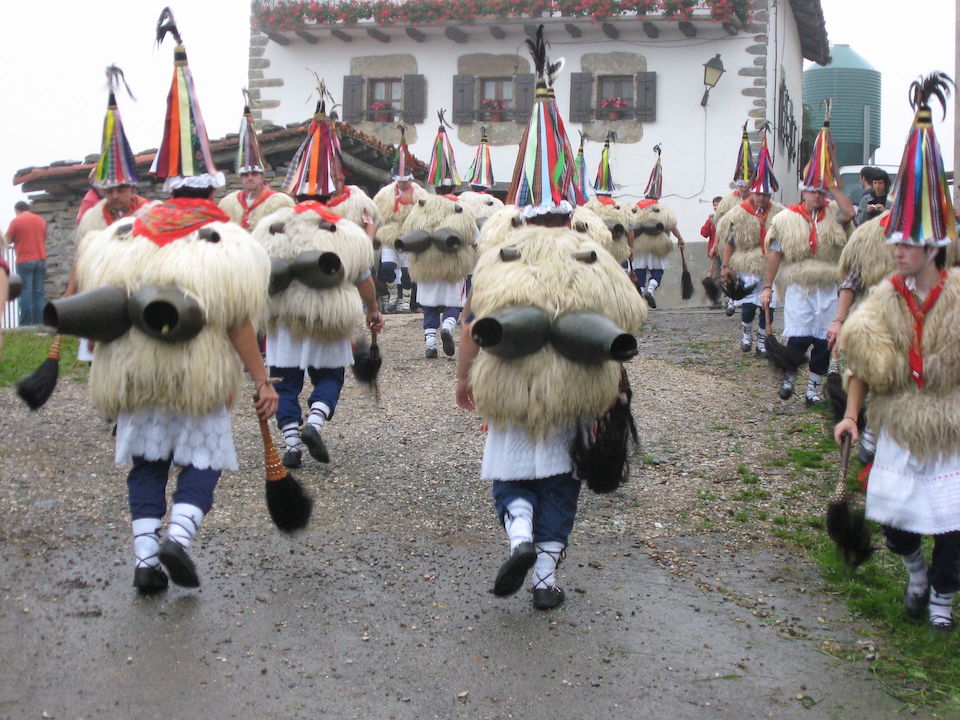The Basque Country has several very distinctive festivals. I’ve written about La Tamborrada and the fiesta of San Juan, but perhaps one of the most unique fiestas involves the Joaldunak. Dressed in sheepskins and tall pointy hats with massive cowbells hung on their backs, these men, and now women, march between the towns of Zubieta and Ituren in Nafarroa. Other revelers dress in outlandish costumes, representing the evil spirits they all want to drive away.

- The Joaldunak are part of festivities that take place in the north of Nafarroa, primarily the towns of Ituren and Zubieta, at the end of January. Their costumes feature cowbells that hang at their waist and these bells give the Joaldunak their name. The Basque word for cowbell – in general, as there is a separate word pulunpa for the largest cowbell that they actually – is joarea. Thus, the Joaldunak are those that have the joarea, or cowbells. They represent sheep and there is a sheepherder that also accompanies them, leading another costumed man playing the role of a bear who is used to scare off the wolves. Others dress up as demons and other evil spirits, leading to a pretty wild celebration.
- The Joaldunak introduce the coming carnival, the origins of which have been lost. They march from Zubieta to Ituren, a nearly-two mile trek. They walk in step so that the bells are synched, in a rhythm matching their march. Half way, the Joaldunak of Zubieta are met by those from Ituren and they complete the march to the Ituren plaza, where some 50-60 Joaldunak meet for a communal lunch. The Joaldunak are said to protect cattle, drive away bad spirits, and ensure a good harvest. Cowbells are one way that Basques have warded off dangerous animals and spirits that would harm their cattle.
- We don’t have a lot of information about what the Joaldunak were before the Spanish Civil War. In Ituren, in addition to their two cowbells, the Joaldunak would wear a black cloth covering their face under a long conical hat called a ttuntturro. The ttunturro was decorated with colorful ribbons. The tip held a rooster feather. The Joaldunak wore sheepskins. The Joaldunak from Ituren would go as a group while in other places, such as Zubieta, they were isolated characters in the celebrations. In some places, they would beg at the houses of their neighborhood.
- After the Spanish Civil War, carnivals such as those featuring the Joaldunak were banned, but Ituren and Zubieta continued their festivities despite the ban. They were able to continue, in part, by compromising and removing the cloth that covered their faces.
- In the 1960s, the celebrations around the Joaldunak evolved. Before that, cowbells were expensive and there weren’t typically more than maybe a dozen Joaldunak at the carnivals. Young people found new cowbells and the groups became bigger. Tourists started coming and the celebrations gained attention. Things became a bit more formalized – the details of the costume became more standard and the timing of the Joaldunak’s participation in the festivities also became more precise.
- Sometimes, the Joaldunak are confused with the Zanpantzar, which are effigies that are burned during the festivals, representing all of the evil that is being burned away. The Zanpantzar is viewed as a villain and, in some places, is tried and condemned for his evil ways and blasphemous language. Sometimes, the word Zanpantzar is also used to refer to the carnival itself.
- Historically, the Joaldunak were men, but recently women have also begun participating and dressing as Joaldunak.
Primary sources: Ortzadar Folklore Taldea. Karlos Irujo Asurmendi. Zanpantzar. Auñamendi Encyclopedia. Available at: https://aunamendi.eusko-ikaskuntza.eus/en/zanpantzar/ar-145982/; Joaldun, Wikipedia; Joaldun, Wikipedia (Basque); The Joaldunak from Head to Toe, Smithsonian Folklife Festival
Discover more from Buber's Basque Page
Subscribe to get the latest posts sent to your email.



The distance from Zubieta to Ituren is 3.6km. Who uses the imperial system these days? Only Myanmar, Liberia, and the USA!
In fact the Joaldunak don’t walk all the way from Zubieta to Ituren. They walk about 500 metres, hop onto trailers and into the backs of vans, and are transported thus to within 500 metres of Ituren to continue the display.
I know all this is true because I live in Zubieta.
I appreciate that – it’s just that most of the people who read this blog are from the United States, so I try to use units that are most familiar. But, I will endeavor to use both going forward.
And thanks for that detail about the vans! I hadn’t seen that in anything I read. Do you know how long they’ve been using vans and trailers? I assume not all that long…?